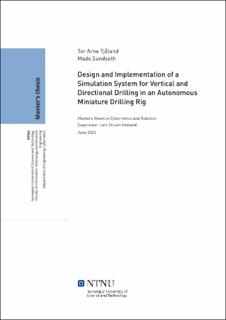| dc.description.abstract | Digitalisering og automatisering av prosesser har i flere bransjer hatt stor påvirkning, særlig over de siste årene. Selv om R&D har utviklet en rekke før manuelle prosesser til å nå bli autonome, gjelder dette fortsatt ikke for oljedrilling. Dette har ført til at the Society of Petroleum Engineers (SPE) opprettet the Drilling System Automation Technical Section (DSATS) for å fremskynde implementeringen av autonom drilling.
Med SPE og DSATS i fronten ble den årlige Drillbotics-konkurransen opprettet, hvor studenter over hele verden blir utfordret til å bygge en autonom miniatyrversjon av en borerigg som skal utføre gitte utfordringer. I år skulle konkurransen opprinnelig avholdes fra 22. til 26. juni, men på grunn av den pågående pandemien, ble den kansellert. Denne masteroppgaven fikk derfor endret sin problemstilling, hvor det nye målet ble å konstruere et simuleringssystem som realistisk klarer å fremstille de fysiske utfordringene boreriggen ville møtt under konkurransen.
Ideen bak simuleringssystemet er at det skal kunne brukes av kommende års Drillbotics-lag for tidlig testing av teorier og kontrollsystemer. For å oppnå enkel testing er programmet implementert i MATLAB og Simulink med en seksjonert tilnærming, slik at deler av programmet lett kan endres. Hoveddelene består av tilstandsdynamikk, tilstandsmaskin, tilstandsestimering, referansegenerator og kontrollere, som alle enkelt kan bli endret og testet.
For å finne den optimale kontrollmetoden for ulike boremiljøer, har det blitt implementert en rekke typer kontrollere bestående av proporsjonal–integral–derivat-kontroller (PID), modell-prediktiv-kontroller (MPC) og ulineær-modell-prediktiv-kontroller (NMPC). For å oppnå realistisk simulering, har tilstandsdynamikken blitt utformet og implementert så nært som mulig den fysiske dynamikken, som også inneholder støy og bias i både prosessen og de simulerte sensorene. For å motvirke støy og bias benyttes et utvidet Kalman-filter. Det er også viktig å sikre et trygt boremiljø, så i tillegg har det blitt implementert en tilstandsmaskin med 9 potensielle tilstander. Til slutt har en referansegenerator med en rekke mulige algoritmer blitt implementert, slik at ulike referansemetoder for kontrollerne kan testes.
Resultatene viser at det er flere fordeler og ulemper med de forskjellige kontroll- og referansemetodene. Valg av disse avhenger av boremiljøet, slik som gitte koordinater, mekaniske begrensninger av det fysiske systemet og andre parametre som bestemmer utfallet av konkurransen. Det ble funnet at simuleringssystemet er et utmerket verktøy for å teste ulike hypoteser og teorier, ettersom det gjør visualisering av systemrespons raskt og enkelt.
Videre kan simuleringssystemet utvides med hensyn til tilstandsdynamikken for å representere den fysiske dynamikken bedre. Det bør også utforskes mer på bruken av NMPC som referansegenerator, da dette burde kunne finne optimal bane for drilling basert på mekaniske begrensninger og poeng-optimalisering i en eventuell konkurranse. | |
| dc.description.abstract | The vast impact of digitalization and automation of processes in multiple industries has become apparent over the past years. While research and development has evolved multiple manual processes to become autonomous, the case for autonomous oil drilling is not the same. Therefore, the Society of Petroleum Engineers (SPE) established the Drilling System Automation Technical Section (DSATS) in order to accelerate the implementations of autonomous drilling.
Initiated in 2014, the Drillbotics competition, with SPE and DSATS in the front, annually challenges students from around the world to build a physical autonomous miniature drilling rig to conquer given challenges. This year, the competition was scheduled to be held 22.-26. June, but got canceled due to the ongoing pandemic. This master's thesis has therefore undergone a change of problem statement, such that the new main goal became to create a simulation system that realistically represents the true drilling environments of the physical competition.
The idea of the simulation system is for it to be used by the next year's Drillbotics team for early control system testing. As such, the program has been implemented in MATLAB and Simulink with a compartmentalized approach, giving interchangeability of blocks for easy testing. The main blocks consist of the state dynamics, state machine, reference generator, controller, and state estimation, and may all be easily edited and tested.
To find the optimal control method for different drilling environments, there has been implemented multiple types of controllers consisting of a proportional–integral–derivative controller (PID), a model predictive controller (MPC), and a nonlinear model predictive controller (NMPC). For accurate state representation, the state dynamics have been designed and implemented close to the true dynamics of the system, containing noise and bias in both the process and simulated sensors. To combat this noise and bias, an extended Kalman filter is used. As well, it is important to ensure a safe drilling environment. As such, a state machine with 9 potential states has been implemented. Lastly, there are multiple viable paths for the drill to follow. A reference generator with multiple optional path algorithms has therefore also been implemented.
The results show that there are multiple use cases for each of the controller methods, as well as the path generation methods. They should be used based on the drilling environment, such as the given coordinate points, mechanical constraints of the physical system, and other parameters that the competition score is based on. It has been found that the simulation system is an excellent tool to test different hypotheses and theories, as it makes visualization of system response fast and easy.
Furthermore, the simulation system could be expanded upon with regards to state dynamics to better represent the true physical dynamics. As well as this, there should also be done more research on using an NMPC for path generation, as this should be better at finding the optimal path based on the mechanical constraints and score-optimization in an eventual competition. | |
